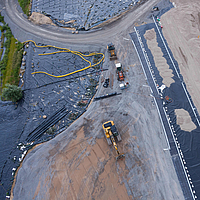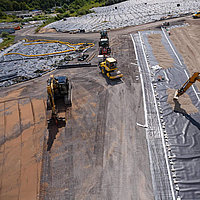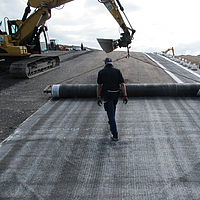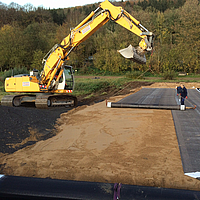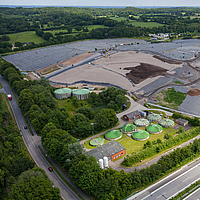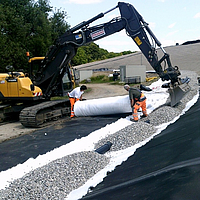Cover lining of the Alt Duvenstedt landfill
Projekt Informationen
Cover lining of the Alt Duvenstedt landfill
Admininstrative district Rendsburg Eckernförde, Schleswig-Holstein, DE
Abfallwirtschaftsgesellschaft Rendburg – Eckernförde mbH
BN Umwelt GmbH, Kremperheide
Strabag Umwelttechnik GmbH, Bereich Bremen; Heers & Brockstedt Umwelttechnik GmbH, Neumünster
November 2014 to October 2015
Projekt Details
Located in the German Federal State of Schleswig-Holstein, the Alt Duvenstedt landfill site, with a total deposition area of approx. 16.2 ha, is operated by waste management company Abfallwirtschaftsgesellschaft Rendsburg-Eckernförde (AWR). It was originally capped in successive phases during the early and mid 1990s using a temporary cover system. A temporary sewage sludge capping and sand layer with grass cover were adopted for the areas below the 27 m ASL contour line. For the landfill sections above the 27 m ASL contour line, AWR used welded (1.0-1.5 mm) PE-HD membranes with sand bags for wind ballasting. After full settlement of the landfill body, AWR decided to install a permanent cover lining over the 41,000 m² area.
The first step entailed the complete removal of the temporary membrane and sand bag capping system. All voids were filled with a mineral levelling material to make the area suitable as a base for geosynthetic clay liners (GCL). After compaction by smooth drum roller, the remaining uneven edges were flattened out by hand.
The first cover lining component, comprising NaBento RL-N GCL, was placed on top of the base layer and the overlaps between the sheets sealed with bentonite powder. The GCL was then overlaid with a vapour barrier in the form of a BAM-approved polymer membrane, as the second lining system component. The longitudinal and transverse joints between sheets were finally welded to provide a liquidproof seal.
Upon completion of the laying, jointing and testing operations, a mineral drainage layer was installed over the temporary haul roads and filled with mixed-grained re-cultivation soil, with the steeper areas being stabilised with erosion control mats. Drainage channels were constructed at the toe of the slopes for the collection and discharge of surface water. To protect the polymer membranes from the 16/32-graded filter gravel, the client specified a HaTe protective nonwoven, type B 800 “O” II, manufactured by HUESKER Synthetic GmbH. The filter gravel layer was covered by a HaTe separating and filter nonwoven, type B 400 “O” II, and the steeper areas successively stabilised by armour stone.
As is standard for landfills, the access routes on the site were designed as pervious surfacings, with a two-layer crushed stone base course and a composite PP grid, in this case Basetrac-Duo C 30 15.
Installation of the GCL was simplified by the fact that the approx. 5.10 m wide bentonite mats had been rolled onto a steel tube at the factory. This allowed straightforward placement using a spreader bar supported from the side by an excavator.
The protective nonwoven installed in the area of the drainage channel ensured reliable protection of the polymer membranes. Filtration stability between the filter gravel and sand layers was guaranteed through the incorporation of a separating and filter nonwoven.

